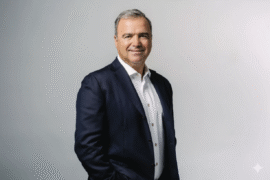This article may contain references to products or services from one or more of our advertisers or partners. We may receive compensation when you click on links to those products or services. Nonetheless, our opinions are our own.
The information presented in this article is accurate to the best of our knowledge at the time of publication. However, information is subject to change, and no guarantees are made about the continued accuracy or completeness of this content after its publication date.
The idea of a happy and contented retirement frequently crosses your mind as you get closer to your prime. You can travel, pursue hobbies, and spend time with loved ones without worrying about money if you wake up every day knowing that $5,000 is coming into your bank account. But how do you turn that dream into reality?
We’ll break down the practical steps and strategies you can implement now to prepare for a retirement that meets your needs and supports the lifestyle you desire. The various components of retirement, including savings plans, investments, and income streams, will empower you to make well-informed decisions that contribute to a financially secure future.
- Planning Your Retirement Income: The Importance of Setting Goals
- Diversifying Your Investments for Long-Term Growth and Security
- Maximizing Your Retirement Accounts: Strategies for Higher Returns
- Determine Your Retirement Needs and Expenses:
- Calculate Your Retirement Nest Egg Goal:
- Develop a Savings and Investment Strategy:
- Explore Income Streams in Retirement:
- Strategies to Optimize Your Retirement:
- Creating a Budget to Support a $5,000 Monthly Lifestyle
- Exploring Passive Income Streams to Supplement Retirement Savings
- Navigating Social Security Benefits: Claiming Strategies for Maximum Impact
- Frequently Asked Questions
- What steps should I take to ensure a $5,000 monthly income in retirement?
- How much should I save for retirement to achieve this income?
- What investment strategies can help generate this monthly income?
- How can Social Security benefits factor into my retirement income?
- What role do pensions play in my retirement income plan?
- How can I minimize taxes on my retirement income?
- What lifestyle adjustments can improve my retirement income strategy?
- How can I prepare for unexpected expenses in retirement?
- Recommended Reads
Planning Your Retirement Income: The Importance of Setting Goals
Setting financial goals for retirement is not just a good idea—it’s essential. Without clarity on what you want to achieve, it’s like embarking on a journey without a destination. Start by defining your retirement vision—think about where you want to live, the lifestyle you wish to maintain, and the activities you want to pursue. Each of these elements will inform the income you need. Consider the following factors when setting your goals:
- Desired lifestyle: Do you envision traveling, hobbies, or simply relaxing at home?
- Healthcare needs: As you age, healthcare costs can increase. Factor these into your plans.
- Emergency fund: An emergency safety net can protect your retirement income.
Once you’ve identified your goals, it’s vital to translate them into concrete, actionable steps. The first step often involves creating a detailed budget that takes into account your projected expenses and income sources. Below is a simple table to help you lay out potential income streams:
| Income Source | Estimated Monthly Income |
|---|---|
| Social Security | $1,500 |
| Pensions | $800 |
| Investments & Savings | $2,000 |
| Part-Time Work | $700 |
By aligning your goals with a structured plan, you position yourself to not just retire, but thrive. These steps are important in ensuring you reach that ideal monthly income of $5,000.
Diversifying Your Investments for Long-Term Growth and Security
Diversifying your investments is one of the most effective strategies to achieve long-term growth and enhance your financial security. By spreading your investments across various asset classes, you minimize risk while maximizing potential returns. Consider incorporating the following options into your portfolio:
- Stocks: These offer the potential for significant capital appreciation, especially if you focus on growth sectors or dividend-paying companies.
- Bonds: Generally less volatile than stocks, bonds can provide a stable stream of income and act as a safety net during market downturns.
- Real Estate: Investing in rental properties or REITs can generate consistent cash flow while also appreciating in value over time.
- Mutual Funds/ETFs: These provide instant diversification and professional management, allowing you to invest in a broad basket of securities without selecting individual stocks or bonds.
- Alternative Investments: Consider assets like commodities, collectibles, or peer-to-peer lending to further diversify and protect against market fluctuations.
To effectively manage your investment strategy, consider allocating your assets according to your risk tolerance and time horizon. Here’s a sample allocation to help you stay balanced:
| Asset Class | Percentage Allocation |
|---|---|
| Stocks | 60% |
| Bonds | 25% |
| Real Estate | 10% |
| Alternative Investments | 5% |
As you assess your investments, remember that periodic rebalancing may be necessary to maintain your desired allocation. This helps you adapt to market changes and stay focused on your long-term financial goals.
Maximizing Your Retirement Accounts: Strategies for Higher Returns
To fully harness the power of your retirement accounts and boost your potential income, it’s essential to explore strategies that align with your goals and risk tolerance. Start by maximizing contributions to your employer-sponsored plans, such as a 401(k). Aim to at least meet the employer match, as this is essentially free money that can grow over time.
Additionally, consider allocating funds to a Roth IRA if you qualify; this allows for tax-free growth and tax-free withdrawals in retirement, making it a valuable asset in your portfolio.
Investing wisely is another important piece of the puzzle. A diversified mix of assets, including stocks, bonds, and real estate, can help balance your portfolio. Consider the following points:
- Risk Assessment: Evaluate your risk tolerance carefully. Your investments should reflect your ability to handle market fluctuations.
- Regular Rebalancing: Monitor your asset allocation and rebalance annually to maintain your risk profile.
- Education and Research: Stay informed about market trends and consider consulting a financial advisor for tailored guidance.
Here’s a summary table of common retirement accounts and their benefits:
| Account Type | Contribution Limits | Tax Treatment |
|---|---|---|
| 401(k) | $19,500 ($26,000 if age 50+) | Tax-deferred |
| Roth IRA | $6,000 ($7,000 if age 50+) | Tax-free growth |
| Traditional IRA | $6,000 ($7,000 if age 50+) | Tax-deferred |
Implementing these strategies can significantly enhance your retirement savings and help you achieve a monthly income of $5,000.
Determine Your Retirement Needs and Expenses:
- Estimate your lifestyle: While $5,000 a month can provide a comfortable retirement in many places, especially outside the most expensive U.S. cities, your actual needs will depend on your desired lifestyle. Consider if you plan to travel extensively, pursue expensive hobbies, or have significant healthcare costs.
- Create a detailed budget: List all your current expenses (housing, food, transportation, healthcare, personal care, utilities, etc.) and anticipate how they might change in retirement. Some expenses, like commuting, may decrease, while others, like healthcare, could increase.
- Account for inflation: The purchasing power of $5,000 today will be less in the future due to inflation. Factor in a realistic inflation rate (e.g., 2-3% annually) to ensure your income keeps pace.
- Consider potential new expenses: Think about expenses related to retirement activities like travel, hobbies, or increased entertainment.
- Healthcare costs: This is a major factor. Plan for Medicare premiums (if in the U.S.) and out-of-pocket costs, and consider supplemental insurance or long-term care insurance.
Calculate Your Retirement Nest Egg Goal:
A common rule of thumb is the “4% rule,” which suggests you can safely withdraw 4% of your investment portfolio in the first year of retirement and adjust for inflation thereafter. To generate $60,000 per year ($5,000/month) using the 4% rule, you would need a retirement nest egg of:
$60,000 (annual income) / 0.04 (4% withdrawal rate) = $1,500,000
This means you would need approximately $1.5 million saved by the time you retire.
Voted "Best Overall Budgeting App" by Forbes and WSJ
Monarch Money helps you budget, track spending, set goals, and plan your financial future—all in one app.
Get 50% OFF your first year with code MONARCHVIP
Develop a Savings and Investment Strategy:
- Start early and save consistently: The power of compound interest is your greatest ally. The earlier you start, the less you’ll need to save each month to reach your goal.
- Maximize retirement accounts:
- 401(k)s and 403(b)s: Contribute as much as possible, especially if your employer offers a matching contribution, which is essentially free money.
- IRAs (Traditional and Roth): These offer tax advantages. Traditional IRA contributions may be tax-deductible, while Roth IRA withdrawals are tax-free in retirement.
- Health Savings Accounts (HSAs): If you have a high-deductible health plan, an HSA offers a triple tax advantage: tax-deductible contributions, tax-free growth, and tax-free withdrawals for qualified medical expenses. This can be a powerful retirement savings vehicle.
- Diversify your investments: Don’t put all your eggs in one basket. A diversified portfolio typically includes a mix of:
- Stocks: Offer potential for higher growth, but also higher risk. Consider index funds or ETFs that track broad market indexes like the S&P 500 for broad diversification.
- Bonds: Generally less volatile than stocks, providing stability and income.
- Real Estate: Can provide rental income and appreciation, but also comes with management responsibilities.
- Adjust your risk tolerance over time: As you get closer to retirement, gradually shift your asset allocation from more aggressive (higher stock exposure) to more conservative (higher bond exposure) to protect your accumulated savings from market downturns. Target-date funds can automate this process.
- Consider professional guidance: A financial advisor can help you create a personalized retirement plan, assess your risk tolerance, and choose appropriate investments. Robo-advisors offer automated, low-cost investment management.
Explore Income Streams in Retirement:
To achieve $5,000 a month, you’ll likely rely on a combination of sources:
- Investment Portfolio Withdrawals: As calculated above, this will be a significant portion.
- Social Security Benefits: Understand your estimated Social Security benefits and when to claim them. Delaying claiming past your full retirement age (up to age 70) can significantly increase your monthly payments.
- Pensions (if applicable): If you have a pension, factor it into your income calculations.
- Part-time work: Many retirees choose to work part-time to supplement their income, stay engaged, and maintain a sense of purpose.
- Rental Income: If you own rental properties, this can provide a consistent cash flow.
- Annuities: These insurance products can provide a guaranteed stream of income for life, which can be valuable for covering essential expenses.
Strategies to Optimize Your Retirement:
- Pay off debt before retirement: Eliminating mortgage payments, car loans, and other consumer debt will significantly reduce your monthly expenses in retirement.
- Consider downsizing or relocating: Moving to a smaller home or a lower cost of living area can free up substantial funds. Some popular retirement spots for a $5,000 monthly budget include New Orleans, Nashville, Indianapolis, The Villages (Florida), and San Juan (Puerto Rico).
- Minimize taxes: Strategize your withdrawals from different retirement accounts (taxable, tax-deferred, tax-free) to minimize your overall tax burden in retirement. Consult with a tax professional.
- Regularly review and adjust your plan: Life changes, market conditions fluctuate, and your goals may evolve. Review your retirement plan annually and make adjustments as needed.
Creating a Budget to Support a $5,000 Monthly Lifestyle
Building a budget that accommodates a $5,000 monthly lifestyle involves careful planning and awareness of your financial situation. Begin by assessing your fixed expenses:
- Housing Costs: Rent or mortgage, property taxes, and homeowner’s insurance
- Utilities: Electricity, gas, water, and internet services
- Transportation: Car payments, insurance, fuel, and public transportation
Next, account for your variable expenses:
- Groceries: Food, household supplies, and personal care items
- Entertainment: Dining out, subscriptions, and recreational activities
- Healthcare: Insurance premiums, medications, and out-of-pocket costs
Here’s a sample budget:
| Category | Estimated Monthly Cost |
|---|---|
| Housing | $1,500 |
| Utilities | $300 |
| Transportation | $400 |
| Groceries | $600 |
| Entertainment | $300 |
| Healthcare | $500 |
| Total | $4,600 |
This example leaves room for unexpected expenses or savings. Regularly review and update your budget to reflect lifestyle changes and stay in control of your spending.
Exploring Passive Income Streams to Supplement Retirement Savings
Diversifying your income sources can ease the transition into retirement and add financial stability. Passive income can complement your savings and elevate your quality of life. Consider these options:
- Real Estate Investments: Rental properties can offer a reliable income stream. Start small with a single-family home or explore platforms that simplify property management.
- Dividend Stocks: Invest in established companies that pay regular dividends to generate consistent income.
- Peer-to-Peer Lending: Lend directly to individuals or small businesses and earn interest on your capital.
- Digital Assets: Create an eBook, online course, or blog that earns ad revenue. These assets can generate ongoing income after the initial setup.
Here’s a breakdown of potential monthly income:
| Income Source | Estimated Monthly Income |
|---|---|
| Real Estate Rentals | $1,500 |
| Dividend Stocks | $800 |
| Peer-to-Peer Lending | $400 |
| Digital Products | $600 |
| Total | $3,900 |
Start with what you have, invest wisely, and stay focused on your retirement income goals.
You can significantly increase your Social Security benefits with strategic planning. Consider the following tips:
- Timing Your Claim: Delay benefits until full retirement age or even age 70. Each year of delay past full retirement age can increase your benefits by up to 8%.
- Spousal Benefits: If married, explore spousal benefits to potentially increase household income.
- Working While Claiming: If you claim early but continue working, be aware of income limits that may reduce your benefits temporarily.
- Tax Considerations: Your benefits may be taxable depending on total household income. Plan accordingly to minimize tax burdens.
Here’s a sample comparison of monthly and annual benefits:
| Age to Claim | Monthly Benefit (Approx.) | Total Annual Benefits |
|---|---|---|
| 62 | $1,500 | $18,000 |
| 67 (Full Retirement Age) | $2,000 | $24,000 |
| 70 | $2,640 | $31,680 |
Making informed decisions about Social Security can add thousands to your retirement income.
Frequently Asked Questions
What steps should I take to ensure a $5,000 monthly income in retirement?
Assess your financial situation, including savings, investments, and income sources like Social Security and pensions. Create a detailed retirement budget and determine how much you need to save monthly to reach your target.
How much should I save for retirement to achieve this income?
A common rule of thumb is to save 25 times your desired annual income. For a $5,000/month income, that equals about $1.5 million. However, your unique situation may require more personalized calculations.
What investment strategies can help generate this monthly income?
Consider a mix of dividend-paying stocks, REITs, and bonds. A diversified portfolio combining growth assets and stable income investments helps meet your target while managing risk.
Use the SSA estimator to project benefits at different ages. Delaying your claim increases monthly benefits, while early claims reduce them. Strategize based on health, income needs, and longevity expectations.
What role do pensions play in my retirement income plan?
If you have a pension, review payout options and how it integrates with Social Security. Understanding these details helps you calculate total income and decide whether extra savings are needed.
How can I minimize taxes on my retirement income?
Use tax-advantaged accounts like Roth IRAs for early retirement years. Withdraw strategically from taxable, tax-deferred, and tax-free accounts to lower your tax burden. Consult a tax advisor for customized planning.
What lifestyle adjustments can improve my retirement income strategy?
Consider downsizing, relocating to a lower-cost area, and reducing discretionary expenses. Adding part-time work or passive income streams can also enhance your monthly cash flow.
How can I prepare for unexpected expenses in retirement?
Establish an emergency fund with at least six months of living expenses. Long-term care insurance can help protect your assets from high healthcare costs later in life.

Reviewed and edited by Albert Fang.
See a typo or want to suggest an edit/revision to the content? Use the contact us form to provide feedback.
At FangWallet, we value editorial integrity and open collaboration in curating quality content for readers to enjoy. Much appreciated for the assist.
Did you like our article and find it insightful? We encourage sharing the article link with family and friends to benefit as well - better yet, sharing on social media. Thank you for the support! 🍉
Article Title: How To Retire With A Potential ,000 Monthly Income
https://fangwallet.com/2025/06/02/how-to-retire-with-a-potential-5000-monthly-income/The FangWallet Promise
FangWallet is an editorially independent resource - founded on breaking down challenging financial concepts for anyone to understand since 2014. While we adhere to editorial integrity, note that this post may contain references to products from our partners.
The FangWallet promise is always to have your best interest in mind and be transparent and honest about the financial picture.
Become an Insider

Subscribe to get a free daily budget planner printable to help get your money on track!
Make passive money the right way. No spam.
Editorial Disclaimer: The editorial content on this page is not provided by any of the companies mentioned. The opinions expressed here are the author's alone.
The content of this website is for informational purposes only and does not represent investment advice, or an offer or solicitation to buy or sell any security, investment, or product. Investors are encouraged to do their own due diligence, and, if necessary, consult professional advising before making any investment decisions. Investing involves a high degree of risk, and financial losses may occur including the potential loss of principal.
Source Citation References:
+ Inspo
There are no additional citations or references to note for this article at this time.












































